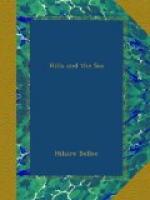There is I know not what in history, or in the way in which it is taught, which makes people imagine that it is something separate from the life they are living, and because of this modern error, you may very well be wondering what on earth this true story of the foundation of our country has to do with the Looe Stream. It has everything to do with it. The sea, being governed by a pagan god, made war at once, and began eating up all those fields which had specially been consecrated to the Church, civilisation, common sense, and human happiness. It is still doing so, and I know an old man who can remember a forty-acre field all along by Clymping having been eaten up by the sea; and out along past Rustington there is, about a quarter of a mile from the shore, a rock, called the Church Rock, the remains of a church which quite a little time ago people used for all the ordinary purposes of a church.
The sea then began to eat up Selsey. Before the Conquest—though I cannot remember exactly when—the whole town had gone, and they had to remove the cathedral to Chichester. In Henry VIII’s time there was still a park left out of the old estates, a park with trees in it; but this also the sea has eaten up; and here it is that I come to the Looe Stream. The Looe Stream is a little dell that used to run through the park, and which to-day,—right out at sea, furnishes the only gate by which ships can pass through the great maze of banks and rocks which go right out to sea from Selsey Bill, miles and miles, and are called the Owers.
On the chart that district is still called “The Park,” and at very low tides stumps of the old trees can be seen; and for myself I believe, though I don’t think it can be proved, that in among the masses of sand and shingle which go together to make the confused dangers of the Owers, you would find the walls of Roman palaces, and heads of bronze and marble, and fragments of mosaic and coins of gold.
The tide coming up from the Channel finds, rising straight out of the bottom of the sea, the shelf of this old land, and it has no avenue by which to pour through save this Looe Stream, which therefore bubbles and runs like a mill-race, though it is in the middle of the sea.
If you did not know what was underneath you, you could not understand why this river should run separate from the sea all round, but when you have noticed the depths on the chart, you see a kind of picture in your mind: the wall of that old mass of land standing feet above the floor of the Channel, and the top of what was once its fields and its villas, and its great church almost awash at low tides, and through it a cleft, which was, I say, a dell in the old park, but is now that Looe Stream buoyed up on either side, and making a river by itself running in the sea.




